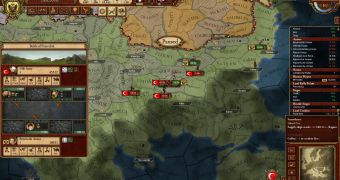March of the Eagles is not an easy game to dominate, even when fighting against the Artificial Intelligence, and the best thing I have ever done to increase my chances was to simply learn how to use March to the Sound of Guns in an effective manner.
This is an option for any land army on the map that can be turned on or off (first gamers might need to actually research it using their ideas menu, depending on the country they are playing).
Basically, it tells a force to move when a battle is engaged nearby, in order to help allies and defeat enemies who are trying to break the line.
Turning it on means that players can focus on the strategic picture and their overall goals rather than simply focusing on micro-managing each individual army.
Forces who are marching to the sound can also deploy more quickly to neighboring provinces, increasing reaction times that are crucial to success.
The tech also encourages both human players and the computer to actually create battle lines rather than simply creating big armies (supply is another limitation in this regard) and quickly marching to their objectives.
My initial tactic was to turn March to the Sound of Guns on for all my armies, but that’s not a good idea because it takes sieging armies away from position and wastes time in the long run.
After a while, I understood that the idea was to divide my forces based on their overall use and apply judicious use of the tactic.
One or two big infantry and artillery armies are designated for sieges, get defensive commander and don’t ever march because they need to absorb counterattacks and take ground.
Smaller armies, built ideally around guards, cavalry and smaller artillery contingents, have March activated and block advance routes, supporting the main force and deploying to help it take down attackers.

 14 DAY TRIAL //
14 DAY TRIAL //